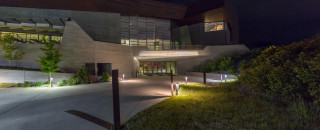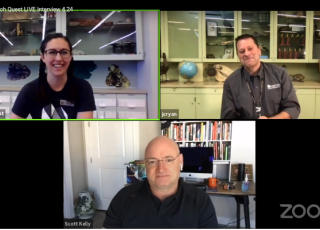Consortium for Dark Sky Studies
The University of Utah has awarded formal recognition to the Consortium for Dark Sky Studies (CDSS), the first academic center in the world dedicated to discovering, developing, communicating, and applying knowledge pertaining to the quality of the night skies.
The CDSS is an interdisciplinary, multi-institutional research group based in the College of Architecture and Planning at the U. The consortium of over 25 university, industry, community and governmental partners will research the global issue of light pollution, and the public health, economic, and environmental impacts of the so-called “disappearing dark.”
“The importance of this issue reaches far beyond Utah’s borders. The consortium addresses the global issue: how to preserve dark skies and reduce the planet’s seemingly relentless increase, with multiple impacts, in light pollution,” remarks Stephen Goldsmith, co-director of CDSS and associate professor of city and metropolitan planning at the U. “The related trans-disciplinary subjects of research, both abundant and complex, make the consortium a critically important resource for communities in the developed and developing world.”
A member of CDSS, The Natural History Museum of Utah recently earned a new International Dark-Sky Association Lighting Design Award, making the museum Utah’s first dark sky-designed public building. The museum is located at the University of Utah and housed in the Rio Tinto Center, nestled in the foothills of the Wasatch Mountain Range.
"We so appreciate receiving this recognition for our dark-sky lighting design. The Museum was conceived as an extension of the natural environment with integrated architecture, site, and exhibitions,” said Sarah George, executive director of the Natural History Museum of Utah. “From the start of design, we knew we wanted our lighting to have minimal impact on our site, and today it is a great place to set up telescopes and stargaze in the city.”
“The Wasatch Range is a national laboratory. You have light from the metropolitan area in the front, but the backside is really dark. It’s like a night and day comparison,” says Dave Kieda, dean of graduate studies and professor of physics and astronomy at the U, and co-director of the CDSS. “There’s a philosophical aspect to the night sky. Faced with the beauty of it all, you ask those big science questions to understand the world around you.”
Utah is uniquely positioned to host studies of the dark sky. The vast tracts of public land and concentration of national parks and monuments provide substantial night skies unpolluted by man-made light that represent a boon of research opportunities. The consortium’s official status has already spurred international collaborations; the CDSS will partner with the leading international research group, ALAN (Artificial Light at Night,) to host the largest global conference to date examining the many aspects and impacts of artificial light. The ALAN conference will convene at Snowbird Ski and Summer Resort in November 2018.
The International Dark-Sky Association (IDA) has designated more International Dark-Sky places in Utah than in any other state, province or country in the world, making the state a leader in preserving the night skies. The opportunity to view the Milky Way galaxy draws dreamers and dollars to Utah and its gateway communities, says Janet Muir, head of the Ogden Valley Chapter of the IDA, and co-founder of the CDSS. The celestial sprawl is only visible in deeply dark skies, a resource that is slowly disappearing from the developed world. Light pollution blocks the view of the Milky Way for nearly 80 percent of North Americans.
“Fewer than one percent of us are astronomers, but 99 percent have a strong cultural relationship to the dark sky,” says Muir. “This is the first cross disciplinary center that studies not only the science, but the culture of dark skies.”
“One of the crises of our time is a crisis of imagination. We used to look up and ask, ‘Who am I?’ Instead of looking up, we’re looking down at our phones, looking for constellations in our apps. Preserving the dark skies allows us to reconnect with our milky way,” says Goldsmith.
The Consortium for Dark Sky Studies:
Institutional Members:
· University of Utah, Brigham Young University, Dixie State University, Salt Lake Community College, Southern Utah University, Utah State University, Utah Valley University, Weber State University, Westminster College.
Affiliate Members:
· Boise State University (Monica Hubbard, assistant professor, Department of Public Policy and Administration); Colorado Mesa University (Tim Casey, director, Center for Natural Recourses); Northern Arizona University (Nadine Barlow, professor, Department of Physics and Astronomy); Ohio Northern University (Bryan Boulanger, Chair, Department of Civil and Environmental Engineering) Rensselaer Polytechnic Institute (Mark Rea, director, Lighting Research Center); University of Wyoming (Carlos Martinez del Rio, director, Berry Biodiversity Conservation Center)
Consortium Steering Group:
· University of Utah
o Keith Bartholomew, Chair, Department of City and Metropolitan Planning; Tariq Banuri, Professor, Department of Economics and Lecturer and City and Metropolitan Planning; Kelly Bricker, Chair, Department of Parks Recreation and Tourism; Jess Dwyer, Academic Program Manager, Center for Science and Math Education; Cynthia Furse, Associate Vice-President for Research, Professor, Department Electrical and Computer Engineering; Stephen Goldsmith, Director, Capstone Initiatives Undergraduate Studies, Associate Professor, City and Metropolitan Planning; Bill Johnson, Professor, Department of Geology & Geophysics; Dave Kieda, Dean of the Graduate School; Professor, Department of Physics and Astronomy; John Lin, Associate Professor, Department of Atmospheric Sciences; Gabriel Lozada, Associate Professor, Department of Economics; Kevin Perry, Chair, Department of Atmospheric Sciences ; Glenn Prestwich, Professor, Medicinal Chemistry; Dave Strayer, Professor, Department of Psychology
· Brigham Young University
o Mike Joner, Associate Research Professor; J. Ward Moody, Professor; Denise Stephens: Associate Professor of the Department of Physics and Astronomy
· Salt Lake Community College
o Steve Crossland, Chair, and Adam Dastrup, Associate Professor of Environmental Science and Sustainability
· Dixie State University
o Alex Chamberlain, Assistant Professor, Art Department
· Southern Utah University
o Kelly Goonan, Director, Outdoor Recreation in Parks and Tourism; Cameron Pace, Professor, Department of Physics, College of Science & Engineering
· Utah State University
o Maura Hagan, Dean, College of Science; Jan Sojka, Chair, Department of Physics; Tonya Triplett, Principal Lecturer, Department of Physics
· Utah Valley University
o Karl Haisch, Professor, Department of Physics; Joe Jensen, Associate Professor, Department of Physics; Kim Nielsen: Asstistant Professor, Department of Physics
· Weber State University
o Laine Berghout, Chair, Department of Chemistry; Jeremy Bryson, Assistant Professor, Department of Geography; John Cavitt, Professor, Department of Zoology ; Rick Ford, Chair, Department of Geosciences; Adam Johnston, Department of Physics; David Matty, Dean, College of Science; Stacy Palen, Professor, Department of Physics
· Westminster College
o Julia Kamenetzky, Assistant Professor, Department of Physics
· State of Utah
o Patrick Barickman, Manager, Technical Analysis, Utah Division of Environmental Quality; Justina Parson-Bernstein, Heritage and Interpretation Manager, Utah State Parks
· Salt Lake City
o Molly Robinson, Urban Design, SLC Planning Division
· Tracy Aviary
o Tim Brown, Executive Director
· Natural History Museum of Utah
o Sarah George, Executive Director; Becky Menlove, Associate Director
· Clark Planetarium
o Thomas Quayle, Education Program Specialist
· International Dark-Sky Association
o John Barentine (Tucson, AZ),
· Ogden Valley Starry Nights
o Ron Gleason, Richard Menzies, and Janet Muir
Advisors:
· Micah Austin, Director Planning & Building, City of Ketchum (ID), Robin Carbaugh, President, Carbaugh Associates, Salt Lake City; Tom Dansie, Director Community Development, Springdale Town, UT; Glenn Heinmiller, partner, Lam Partners, Cambridge, MA, chair, Energy and Sustainability Committee, Illuminating Engineering Society; Britte Kirsch, Regional Coordinator, Southwest, National Parks Conservation Association ; Jay Kinghorn, Director Digital Strategy, Utah Office of Tourism ; Douglas Larsen, Director, Economic Development Partnership, Weber County; Dan Moore, Supervisor, Water Quality and Hazardous Waste Bureau, Salt Lake County; David Nimkin, Senior Regional Director, Southwest, National Parks Conservation Association
Press contacts and links
-
Press Contact
Beth Mitchell



